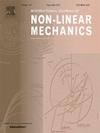Static and dynamic nonlinear behavior and instabilities of a multistable system consisting of two shallow coupled arches
IF 2.8
3区 工程技术
Q2 MECHANICS
International Journal of Non-Linear Mechanics
Pub Date : 2025-03-14
DOI:10.1016/j.ijnonlinmec.2025.105087
引用次数: 0
Abstract
Increased attention has been lately given to multistable systems that use the snap-through buckling of each unit to attain a desired hysteretic force-deformation response. Many of these systems consist of chains of bistable elements flexibly or rigidly connected and respond to an applied load or displacement in a progressive manner. However, little is known of their nonlinear static and dynamic nonlinear behavior and stability. This paper investigates the nonlinear response of multistable structure composed of two simply-supported or clamped buckled beams connected in series by a stiff frame. The resulting multistable system is subject to a transverse force applied at the top of the upper arch. The Lagrangian of the system is obtained and the nonlinear equilibrium equations and equations of motion are derived by the Ritz approach applying the energy stability criterion and Hamilton's principle respectively. Both local and global analyses are numerically conducted to clarify the nonlinear dynamics of the multistable model. Applying brute force and continuation techniques, the coexisting stable and unstable nonlinear equilibrium paths are obtained and the bifurcation points identified. This analysis is aided by the investigation of the potential energy landscape and the basins of attraction of the damped system. The influence of the rise-to-span ratio is clarified and the influence of different ratios on the energy required for switching from one stable state to another, escaping through a saddle channel, is discussed. When subjected to a harmonic excitation the multistable system exhibits coexisting bifurcation sequences starting at each potential well, which can merge leading to large amplitude cross-well motions. The diverse resonance regions are investigated using bifurcation diagrams, phase-space portraits, Poincaré maps and basins of attraction. This study can be used as a basis for the nonlinear analysis of more complex multistable structures constituted by several bistable units.
求助全文
约1分钟内获得全文
求助全文
来源期刊
CiteScore
5.50
自引率
9.40%
发文量
192
审稿时长
67 days
期刊介绍:
The International Journal of Non-Linear Mechanics provides a specific medium for dissemination of high-quality research results in the various areas of theoretical, applied, and experimental mechanics of solids, fluids, structures, and systems where the phenomena are inherently non-linear.
The journal brings together original results in non-linear problems in elasticity, plasticity, dynamics, vibrations, wave-propagation, rheology, fluid-structure interaction systems, stability, biomechanics, micro- and nano-structures, materials, metamaterials, and in other diverse areas.
Papers may be analytical, computational or experimental in nature. Treatments of non-linear differential equations wherein solutions and properties of solutions are emphasized but physical aspects are not adequately relevant, will not be considered for possible publication. Both deterministic and stochastic approaches are fostered. Contributions pertaining to both established and emerging fields are encouraged.

 求助内容:
求助内容: 应助结果提醒方式:
应助结果提醒方式:


